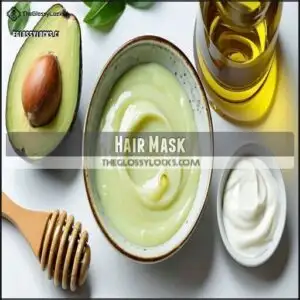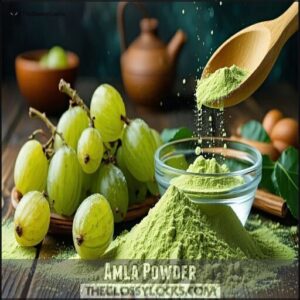This site is supported by our readers. We may earn a commission, at no cost to you, if you purchase through links.
 Amla oil for hair growth is like a nutrient-packed smoothie for your scalp.
Amla oil for hair growth is like a nutrient-packed smoothie for your scalp.
It’s loaded with vitamin C, antioxidants, and essential fatty acids that strengthen hair follicles, boost blood circulation, and encourage thicker, healthier strands.
By nurturing your scalp and reducing inflammation, it can help prevent hair loss while promoting hair growth.
Plus, its moisturizing properties combat dryness, leaving your hair soft and shiny.
If you’re battling dandruff or brittle ends, amla oil might just be the TLC your hair needs.
Curious if it works for your hair type or how to use it effectively? Stick around for practical tips and details!
Table Of Contents
- Key Takeaways
- What is Amla Oil?
- The Benefits of Amla Oil for Hair
- How to Use Amla Oil for Hair
- Possible Side Effects of Amla Oil
- Does Amla Oil Work for All Hair Types?
- How is Amla Oil Made?
- What to Know Before Using Amla Oil on Your Hair
- Summing Up on Amla Oil for Hair
- Frequently Asked Questions (FAQs)
- Does amla oil help hair grow?
- What are the disadvantages of amla hair oil?
- Can I put amla oil on my hair every day?
- How long does amla take to regrow hair?
- How long should I leave Amla Oil in my hair?
- Are there any shampoos or conditioners that contain Amla Oil?
- Does Amla Oil work better for men or women?
- Can Amla Oil be used as a styling product?
- How long does amla oil last when stored?
- Can amla oil be mixed with other oils?
- Conclusion
Key Takeaways
- Amla oil boosts hair growth by nourishing follicles, improving scalp circulation, and extending the hair’s growth phase while reducing DHT levels that cause hair loss.
- It fights dandruff, reduces inflammation, and balances scalp oil production, creating an ideal environment for healthier hair.
- Regular use moisturizes strands, repairs split ends, and strengthens hair, making it shiny, soft, and less prone to breakage.
- Patch test before use to avoid irritation, and for best results, apply 2–3 times weekly, leaving it on for at least 20 minutes or overnight.
What is Amla Oil?
The ancient wisdom of Ayurvedic medicine brings us amla oil, derived from the Indian gooseberry (Phyllanthus emblica).
A timeless Ayurvedic treasure, amla oil nourishes hair with antioxidants, strengthens follicles, and promotes vibrant, healthy locks naturally.
This golden elixir has been treasured for centuries across the Indian subcontinent for its remarkable hair benefits.
Rich in vitamin C, antioxidants, and essential fatty acids, amla oil’s composition makes it a powerhouse for scalp health.
Traditionally prepared by infusing dried amla fruits in carrier oils like coconut or sesame, this preparation method guarantees maximum nutrient extraction.
You’ll find both commercial and homemade versions available, with historical uses dating back thousands of years.
Its natural properties make it particularly effective for strengthening hair follicles.
The Benefits of Amla Oil for Hair
You’ll find that amla oil works wonders for your hair by stimulating follicles with its rich vitamin C content and potent antioxidants that inhibit 5-alpha reductase (similar to finasteride).
Your regular use of this ancient Ayurvedic remedy can transform brittle, thinning locks into stronger, thicker hair.
While also regulating scalp oil production and preventing premature graying with its rich vitamin C content.
Hair Growth
While many hair oils promise results, amla oil actually delivers by targeting the root causes of stunted hair growth.
Amla oil transforms hair by addressing the root causes of stunted growth, delivering stronger, thicker, and healthier locks naturally.
Research shows it effectively promotes the anagen phase of your hair follicles, helping you achieve longer, stronger locks.
- Blocks DHT production through natural 5-alpha reductase inhibition
- Enhances scalp circulation to nourish hair follicles
- Triggers cellular regeneration in the scalp
- Extends the growth phase of hair, as confirmed by 2024 clinical studies
Dandruff Prevention and Scalp Health
Consistently, amla oil tackles dandruff while nurturing your scalp’s microbiome. This powerhouse treatment fights fungi that cause those embarrassing white flakes through its natural antiseptic properties.
Unlike harsh chemicals that strip your scalp, amla oil maintains hydration balance while regulating sebum production.
When incorporated into your hair care routine, you’ll experience:
- Reduced inflammation and itchiness through anti-inflammatory compounds
- Enhanced scalp circulation that promotes healthier follicles
- Natural exfoliation methods that remove dead skin cells
- Balanced oil production preventing both dryness and excess oiliness
Think of amla oil as your scalp’s personal trainer – consistently working to strengthen its defenses while creating the ideal environment for hair growth.
Moisturizes and Nourishes Hair
While keeping your scalp healthy is essential, amla oil’s nourishing properties take your hair care routine to new heights.
This nutrient-rich oil works like a drink of water for parched strands, delivering deep hair hydration and scalp nourishment.
Packed with vitamins C and E, it repairs split ends, enhances shine, and forms a protective barrier around your cuticles.
Users report softer, more manageable locks after just a few applications of this remarkable hair thickening oil that provides deep hair hydration.
Prevents Hair Loss
While nourished hair looks beautiful, preventing hair loss is what keeps your mane full and vibrant.
Amla oil works as a natural DHT inhibition powerhouse, similar to prescription treatments but without harsh chemicals.
It extends the anagen (growth) phase of your hair follicles while improving scalp circulation.
The oil’s rich fatty acids contribute to breakage reduction and follicle strengthening, making it an effective hair loss treatment that works at the root cause.
Amla oil can also help address nutritional deficiency problems, which are known to cause hair shedding.
How to Use Amla Oil for Hair
You’ll maximize amla oil’s hair-transforming benefits by applying it directly to your scalp with a gentle massage, allowing the vitamin C and antioxidants to penetrate hair follicles and stimulate growth.
For best results, leave the oil on for at least 30 minutes before shampooing, though many hair enthusiasts swear by the overnight treatment for that extra boost of nourishment.
Scalp Application
Scalp application is where amla oil truly works its magic for hair growth. For maximum benefits, warm the oil slightly and apply it directly to your scalp using your fingertips. The key is proper massage technique, which enhances scalp circulation and promotes better product absorption into your hair follicles.
Consider exploring various massage tools for enhanced benefits. When applying amla oil to your scalp, remember these techniques:
- Use gentle circular motions with your fingertips for 5-10 minutes to stimulate blood flow
- Focus on areas where thinning occurs for targeted hair growth oil benefits
- Apply light pressure—enough to move the scalp but not cause discomfort
For best results, consider an overnight treatment. Simply apply before bed, cover with a shower cap, and rinse in the morning. Your scalp health will improve noticeably with consistent weekly applications, leading to stronger, thicker hair.
Pre-hair Wash Detangler
After treating your scalp, amla oil serves another powerful purpose as a pre-wash detangler. Before shampooing, warm 2-3 drops of amla oil between your palms and gently work it through your hair from mid-lengths to ends.
The oil’s smooth consistency creates a protective barrier that helps your comb glide through knots without breakage. This technique works particularly well for curly or coarse hair types prone to tangling.
You’ll notice immediate detangling benefits while the oil simultaneously strengthens hair shafts from within. For enhanced results, combine amla with lightweight coconut oil (1:2 ratio) for added slip without weighing hair down.
Many users report noticeably less breakage during their detangling routine when using this method. Leave the oil on for 15-30 minutes before washing to allow the strengthening compounds to penetrate deeply, promoting long-term hair growth and resilience.
Hair Mask
Three simple DIY recipes can transform your amla oil into a potent hair growth mask. For an overnight mask, combine 2 tablespoons of amla oil with coconut milk and honey, applying it from roots to tips.
Let the ingredient synergies work their magic while you sleep. If you prefer quick treatments, mix amla oil with yogurt for a 30-minute hair treatment that strengthens follicles.
For those battling dryness, blend amla oil with avocado for deep conditioning. Besides amla oil masks, you can also explore other DIY hair treatments for different hair needs.
The ideal mask frequency is once weekly, though those with excessive hair fall may benefit from twice-weekly application. Always massage the mixture thoroughly into your scalp, where amla’s growth-stimulating properties are most effective.
Possible Side Effects of Amla Oil
While amla oil offers impressive benefits for hair health, you should be aware of potential side effects before incorporating it into your routine. Despite its natural origins, not everyone’s scalp reacts the same way.
- Allergic reactions may include redness, itching, or scalp irritation
- Hair dryness can occur if you overuse the oil or don’t rinse properly
- Oil buildup might lead to clogged follicles if used too frequently
- Skin staining is possible with darker formulations
- UV exposure may intensify reactions in some individuals
Always perform a patch test before applying amla oil to your entire scalp. Some individuals may also experience irritated scalp conditions, necessitating careful monitoring to avoid clogged follicles and ensure hair health.
Does Amla Oil Work for All Hair Types?
Yes, amla oil works effectively for all hair types, making it a versatile addition to anyone’s hair care routine.
Whether you have straight, wavy, curly, or coily hair, this Ayurvedic hair oil adapts to different hair textures and porosity levels.
It’s particularly beneficial for those with dry, brittle ends and oily scalp conditions.
The lightweight formula penetrates deeply without weighing down even the finest hair strands.
Ethnic differences in hair structure don’t limit its effectiveness—studies show consistent benefits across diverse hair types.
For ideal product interaction, apply it directly to your scalp and hair, allowing the rich antioxidants to work their magic.
How is Amla Oil Made?
You’ll find the traditional process of making amla oil involves soaking dried Indian gooseberry fruits in carrier oils like coconut or sesame, which extracts their potent nutrients and medicinal compounds.
The mixture is typically heated at a low temperature to infuse the oil with amla’s vitamin C, antioxidants, and growth-promoting properties that make it so effective for transforming your hair health.
Amla Fruit or Juice
The humble Indian gooseberry (Phyllanthus emblica) serves as the primary source for authentic amla oil, offering a natural solution for those seeking healthier hair.
When crafting traditional amla oil, the fresh fruit or its juice provides potent nutrients that carrier oils can’t deliver alone.
To extract maximum benefits from amla fruit:
- The ripe fruits are crushed to release their juice, which is then mixed with carrier oils like coconut or sesame
- This mixture undergoes slow heating to allow the therapeutic compounds to infuse into the oil
- The process preserves vitamin C and antioxidants that might be diminished in powdered forms.
The distinctive tart taste of fresh amla doesn’t affect its hair applications, but it does explain why many prefer using it in oil form rather than direct application.
You can find and purchase fresh amla oil online.
Regular use of fruit-derived amla oil strengthens hair follicles and promotes growth through improved scalp circulation.
Amla Powder
Harness the power of amla powder, a hair growth remedy packed with antioxidants and vitamins C and E.
To create amla oil, gently heat the powder with coconut or sesame oil, then strain and store in a glass jar for freshness.
This Indian gooseberry treasure strengthens hair, reduces hair loss, and promotes shine.
Try powder masks by mixing it with water or yogurt, or combine it with herbs like bhringraj for extra benefits.
You can easily find amla products online.
Proper storage guarantees long-lasting potency for your hair care routine.
What to Know Before Using Amla Oil on Your Hair
Before you start using amla oil, it’s important to know how your skin might react, so a quick patch test is a must.
Also, choosing high-quality, mineral oil-free products guarantees you get the full benefits without unnecessary additives.
Patch Test Recommended
Before you jump into using amla oil for hair growth, take a moment to patch test—it’s quick and could save you from unwanted surprises.
Dab a little oil on a small application area, like behind your ear or inner elbow, and leave it for 24 hours. This test duration helps spot allergy symptoms like redness, itching, or skin irritation. Reading results is simple—if your skin stays calm, you’re good to go.
Why bother? Because even natural products can cause reactions.
- Protect your scalp health by avoiding irritation.
- Gain confidence in your hair oil choice.
- Prevent discomfort from unexpected sensitivity.
- Enjoy peace of mind knowing it’s safe to use.
Recommended Hair Products
When exploring amla oil brands, look for hair products suited to your needs, like lightweight oils, serums, or conditioners.
Check product ingredients—options enriched with Vitamin E, Kakadu plum, or jojoba oil offer added benefits for hair growth and nourishment.
For a personal touch, try DIY amla recipes by infusing dried amla powder into coconut or sesame oil.
Choose hair growth products that match your hair type; user product reviews can help identify the best fit.
Avoid formulas with excessive heat processing or synthetic additives.
Whether you’re after thicker strands or scalp health, amla oil-based hair products can transform your routine effortlessly, providing hair growth and nourishment!
Summing Up on Amla Oil for Hair
Amla oil is a powerhouse for hair health, blending ancient Ayurvedic wisdom with modern needs.
Packed with antioxidants and nutrients, it strengthens hair, promotes growth, and shields against damage from UV rays and pollution.
While research highlights its benefits, like extending the hair’s growth phase, limitations exist, and future studies could uncover more.
For best results, try a homemade mask or quality store-bought oil, and remember, consistent use is key, and pairing amla oil with a balanced routine guarantees stronger, healthier locks.
Integrating amla oil into your routine can also help to balance hair dosha imbalances, according to Ayurvedic principles, and support overall hair health.
Frequently Asked Questions (FAQs)
Does amla oil help hair grow?
Yes, it does! Amla oil supports hair growth by nourishing follicles, boosting circulation, and extending the growth phase.
It also inhibits DHT, which causes hair loss, making it ideal for thicker, healthier, and stronger hair.
What are the disadvantages of amla hair oil?
Imagine luxurious hair but with a catch—amla oil can trigger scalp sensitivity, greasy buildup, or an allergic reaction in rare cases.
Always patch test first, and don’t leave it on excessively to avoid clogged pores.
Can I put amla oil on my hair every day?
Using amla oil daily can moisturize and strengthen your hair, but it might build up over time.
Stick to 2–3 times weekly unless you rinse thoroughly; your scalp needs a break to stay balanced!
How long does amla take to regrow hair?
Hair regrowth with amla oil depends on consistency, usually showing noticeable results in 8-12 weeks.
It extends the hair growth phase, strengthens roots, and reduces hair loss.
Patience and regular use make a big difference.
How long should I leave Amla Oil in my hair?
Leave amla oil in your hair for at least 20 minutes to soak up nutrients.
For deeper nourishment, keep it on overnight.
Always rinse thoroughly to avoid buildup or greasy locks.
Patch test first!
Are there any shampoos or conditioners that contain Amla Oil?
You’ll find shampoos and conditioners with amla oil in Ayurvedic or herbal brands like Dabur, Himalaya, and Khadi Naturals.
They’re great for boosting shine, promoting hair growth, and nourishing your scalp.
Does Amla Oil work better for men or women?
Amla oil works equally well for men and women, tackling hair loss, greying, and scalp health.
Its benefits aren’t gender-specific—it nourishes follicles, strengthens roots, and promotes growth, making it a versatile choice for everyone.
Can Amla Oil be used as a styling product?
Isn’t it wild how your go-to treatment doubles as a styling hack?
Amla oil tames frizz, adds shine, and smooths flyaways.
Rub a few drops on your palms and glide through your strands.
How long does amla oil last when stored?
When stored in a cool, dark place and sealed in a glass jar, amla oil stays fresh for up to one year.
Avoid exposure to sunlight or humidity, as this can reduce its effectiveness.
Can amla oil be mixed with other oils?
You can absolutely mix amla oil with other oils like coconut, argan, or castor oil.
This combination boosts nourishment, enhances hair growth benefits, and lets you customize the treatment for your specific hair needs.
Conclusion
From strengthening strands to soothing scalps, amla oil for hair growth delivers a powerful punch of nutrients your hair craves.
Its natural blend of antioxidants, vitamin C, and fatty acids work together to invigorate follicles, reduce hair loss, and promote luscious locks.
Whether you’ve got curls, waves, or straight tresses, amla oil offers versatile ways to nourish and protect.
Try it as a scalp treatment or mask, and watch your hair thrive with health and shine!
- https://www.instagram.com/nhcgtrichology/
- https://pubmed.ncbi.nlm.nih.gov/37487962/
- http://onlinelibrary.wiley.com/doi/10.1002/cbdv.201700404/abstract
- https://www.degruyter.com/view/j/jbcpp.ahead-of-print/jbcpp-2017-0116/jbcpp-2017-0116.xml
- http://www.sciencedirect.com/science/article/pii/S1995764513601856














